Adapted formaldehyde gradient cross-linking protocol implicates human eIF3d and eIF3c, k and l subunits in the 43S and 48S pre-initiation complex assembly, respectively
- PMID: 31863585
- PMCID: PMC7039009
- DOI: 10.1093/nar/gkz1185
Adapted formaldehyde gradient cross-linking protocol implicates human eIF3d and eIF3c, k and l subunits in the 43S and 48S pre-initiation complex assembly, respectively
Abstract
One of the key roles of the 12-subunit eukaryotic translation initiation factor 3 (eIF3) is to promote the formation of the 43S and 48S pre-initiation complexes (PICs). However, particular contributions of its individual subunits to these two critical initiation reactions remained obscure. Here, we adapted formaldehyde gradient cross-linking protocol to translation studies and investigated the efficiency of the 43S and 48S PIC assembly in knockdowns of individual subunits of human eIF3 known to produce various partial subcomplexes. We revealed that eIF3d constitutes an important intermolecular bridge between eIF3 and the 40S subunit as its elimination from the eIF3 holocomplex severely compromised the 43S PIC assembly. Similarly, subunits eIF3a, c and e were found to represent an important binding force driving eIF3 binding to the 40S subunit. In addition, we demonstrated that eIF3c, and eIF3k and l subunits alter the efficiency of mRNA recruitment to 43S PICs in an opposite manner. Whereas the eIF3c knockdown reduces it, downregulation of eIF3k or eIF3l increases mRNA recruitment, suggesting that the latter subunits possess a regulatory potential. Altogether this study provides new insights into the role of human eIF3 in the initial assembly steps of the translational machinery.
© The Author(s) 2019. Published by Oxford University Press on behalf of Nucleic Acids Research.
Figures
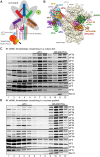
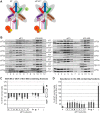

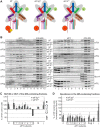
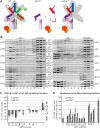
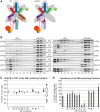
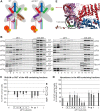

Similar articles
-
Functional and biochemical characterization of human eukaryotic translation initiation factor 3 in living cells.Mol Cell Biol. 2014 Aug;34(16):3041-52. doi: 10.1128/MCB.00663-14. Epub 2014 Jun 9. Mol Cell Biol. 2014. PMID: 24912683 Free PMC article.
-
Eukaryotic translation initiation factor 3 (eIF3) and eIF2 can promote mRNA binding to 40S subunits independently of eIF4G in yeast.Mol Cell Biol. 2006 Feb;26(4):1355-72. doi: 10.1128/MCB.26.4.1355-1372.2006. Mol Cell Biol. 2006. PMID: 16449648 Free PMC article.
-
Human-like eukaryotic translation initiation factor 3 from Neurospora crassa.PLoS One. 2013 Nov 8;8(11):e78715. doi: 10.1371/journal.pone.0078715. eCollection 2013. PLoS One. 2013. PMID: 24250809 Free PMC article.
-
The function and clinical significance of eIF3 in cancer.Gene. 2018 Oct 5;673:130-133. doi: 10.1016/j.gene.2018.06.034. Epub 2018 Jun 22. Gene. 2018. PMID: 29908282 Review.
-
Human eIF3: from 'blobology' to biological insight.Philos Trans R Soc Lond B Biol Sci. 2017 Mar 19;372(1716):20160176. doi: 10.1098/rstb.2016.0176. Philos Trans R Soc Lond B Biol Sci. 2017. PMID: 28138064 Free PMC article. Review.
Cited by
-
Perturbations in eIF3 subunit stoichiometry alter expression of ribosomal proteins and key components of the MAPK signaling pathways.Elife. 2024 Nov 4;13:RP95846. doi: 10.7554/eLife.95846. Elife. 2024. PMID: 39495207 Free PMC article.
-
Structural Differences in Translation Initiation between Pathogenic Trypanosomatids and Their Mammalian Hosts.Cell Rep. 2020 Dec 22;33(12):108534. doi: 10.1016/j.celrep.2020.108534. Cell Rep. 2020. PMID: 33357443 Free PMC article.
-
Translational control of coronaviruses.Nucleic Acids Res. 2020 Dec 16;48(22):12502-12522. doi: 10.1093/nar/gkaa1116. Nucleic Acids Res. 2020. PMID: 33264393 Free PMC article. Review.
-
eIF4E-independent translation is largely eIF3d-dependent.Nat Commun. 2024 Aug 6;15(1):6692. doi: 10.1038/s41467-024-51027-z. Nat Commun. 2024. PMID: 39107322 Free PMC article.
-
Circular RNA circEIF3C promotes intrahepatic cholangiocarcinoma progression and immune evasion via the miR-34a-5p/B7-H4 axis.Genes Dis. 2022 May 19;10(2):370-372. doi: 10.1016/j.gendis.2022.05.005. eCollection 2023 Mar. Genes Dis. 2022. PMID: 37223528 Free PMC article. No abstract available.
References
Publication types
MeSH terms
Substances
Grants and funding
LinkOut - more resources
Full Text Sources
Molecular Biology Databases

